Country guides

Things to do in Tanzania
Synonymous with the Serengeti and the tropical island of Zanzibar, Tanzania is an eco-tourist's dream, a bucket-list destination for wildlife safaris, and an idyllic beach getaway all in one. Wonderful game-viewing opportunities abound in Tanzania and the most popular parks include the Mount Kilimanjaro Game Park and the Serengeti National Park.
The former is most commonly visited by travellers keen to summit the famous Kilimanjaro, a magnificent hike which is surprisingly easy considering the height of the mountain, but should certainly not be attempted without training and planning. The Serengeti National Park, on the other hand, is a prime safari destination, its crowning jewel the annual wildebeest migration, which qualifies as one of the natural wonders of the world.
Off the shore of mainland Africa, Zanzibar is known for crystalline turquoise waters and sandy white beaches on its north shore. Apart from the glorious beaches, resort attractions, and water sports, the mysterious Stone Town intrigues visitors on Zanzibar with its UNESCO-listed melange of 19th-century Swahili, Arab, Indian, and European influences.
The quickest and most comfortable way to travel round this magical country is to fly between cities but, for the more rural areas and game parks, it's advisable to hire a car (preferably a 4x4) or join a tour. For those on a budget, taking the bus is the cheapest and easiest way to travel, but the accident rate is high due to bad roads and overloaded vehicles, so caution should be exercised.
Serengeti National Park
Meaning 'endless plains' in the Masai language, the Serengeti is Tanzania's oldest park and one of the world's best wildlife refuges, continuous with Kenya's Masai Mara Game Reserv…
Serengeti National Park
Meaning 'endless plains' in the Masai language, the Serengeti is Tanzania's oldest park and one of the world's best wildlife refuges, continuous with Kenya's Masai Mara Game Reserve to the north. The open plains are home to an estimated three million large mammals that are involved in seasonal migration, and have the largest concentration of wildlife in the world if the figure includes the population of birds and smaller animals. The Serengeti is famous for the Great Migration, possibly the most astounding occurrence in the animal kingdom that is known to humankind. During this time, millions of hoofed animals, predominantly wildebeest, form one massive herd and leave the dry plains of Tanzania in search of greener grazing and water to the north. Bringing up the rear of the procession are the weak, the young, and the crippled, followed closely by large numbers of vigilant predators, including lions, cheetahs, hyenas, and wild dogs.
Website www.serengeti.org
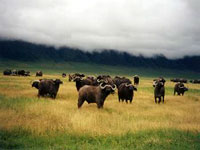
Ngorongoro Conservation Area
Rising above the plains of the Serengeti, the Ngorongoro Conservation Area is a vast, UNESCO-listed protected area that includes the important archaeological site of Olduvai Gorge …
Ngorongoro Conservation Area
Rising above the plains of the Serengeti, the Ngorongoro Conservation Area is a vast, UNESCO-listed protected area that includes the important archaeological site of Olduvai Gorge and its main attraction, the Ngorongoro Crater. Once the site of an active volcano, the crater was formed about two million years ago when its cone collapsed on itself. Today the crater floor, supplied with permanent water and ringed with towering forested sides, serves as a natural cradle for an astounding abundance of wildlife. With an incredible width of 12 miles (20km) and a depth of 2,001ft (610m), the crater is the largest caldera in the world and is home to tens of thousands of animals, including rhino, buffalo, and large herds of zebra and wildebeest. There are also dense concentrations of predators attracted by the large variety of grazers, and prides of lion with magnificent black-maned males are one of the highlights.
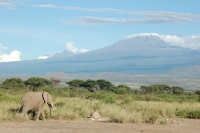
Mount Kilimanjaro National Park
Rising 19,341ft (5,895m) above the African plains, the magnificent solitary peak of Mount Kilimanjaro is the dominant feature of this national park. The lush rainforest on its lowe…
Mount Kilimanjaro National Park
Rising 19,341ft (5,895m) above the African plains, the magnificent solitary peak of Mount Kilimanjaro is the dominant feature of this national park. The lush rainforest on its lower slopes is home to a number of animals including elephant, buffalo, rhino, monkey, and leopard. Its dormant volcano is remarkable in many ways, not only for its snow-covered peaks and glaciers rising out of a humid equatorial jungle, but also because it is the highest freestanding mountain in the world, a huge cone unattached to a mountain range, and Africa's highest peak. Its magnetism has attracted researchers, mountaineers, and adventurers for years. It is the only mountain of its size that can be scaled by inexperienced hikers, although altitude sickness is common and can be fatal. There are six different routes of varying degrees of difficulty, but the easiest and most popular way to reach the summit is on the Marangu Trail, which takes about five days, with nights spent in huts along the way.
Website www.tanzaniaparks.go.tz
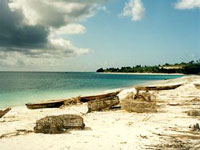
Northern Beaches of Zanzibar
The many superb beaches and picturesque villages around Zanzibar are ideal for those wanting to get away from the bustling town life, and the options along the northeast coast are …
Northern Beaches of Zanzibar
The many superb beaches and picturesque villages around Zanzibar are ideal for those wanting to get away from the bustling town life, and the options along the northeast coast are particularly inviting. Modestly veiled women make bright splashes of colour along stretches of white sandy beach, dhows with curved sails drift along close to shore, and fishermen offer their fresh catches of the day to the simple seaside restaurants. Miles of pristine beaches are dotted with pockets of guesthouses, particularly around Kendwa and the fishing village of Nungwi, which is renowned for its tradition of boat building. There is excellent diving and deep-sea fishing off this coast.
Anglican Cathedral and Slave Market
The colossal Anglican Cathedral in Stone Town is located on the grounds of the island's largest former slave market. The cathedral's altar stands on the exact location of the forme…
Anglican Cathedral and Slave Market
The colossal Anglican Cathedral in Stone Town is located on the grounds of the island's largest former slave market. The cathedral's altar stands on the exact location of the former whipping post, a tree where slaves were brutalised to show their strength and resilience to potential slave owners. Building began in 1873 to commemorate the end of the slave trade and was conducted by Edward Steere, third bishop of Zanzibar and a fervent abolitionist. The cathedral has a combination of Gothic and Arabic styles and is noted for its Basilica shape and barrel vault roof, which the populace believed would never hold. Edward Steere died of a heart attack during construction and was buried behind the altar.
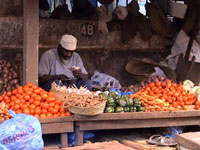
Central Market
A vibrant array of colours and spicy scents lures visitors to the lively Central Market in Stone Town. Opened in 1904, the numerous stalls run over with tropical fruits, exotic spi…
Central Market
A vibrant array of colours and spicy scents lures visitors to the lively Central Market in Stone Town. Opened in 1904, the numerous stalls run over with tropical fruits, exotic spices, brightly coloured khangas (worn by local women), and rare provisions such as pomegranates and red bananas. Locals come daily from the surrounding areas to display their subsistence wares, and fishermen display their catch of the day with a pungent selection of fresh fish from huge marlins to salty sardines. The market is chaotic and can prove a bit overwhelming for some people, but it is an exciting, colourful cultural experience and worth a quick stroll at least. Foodies will enjoy sampling the rare fruits and local specialities. Speaking of food, the best place for a sampling of traditional street food is the night market by the waterfront of the Forodhani Gardens.
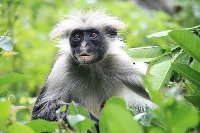
Jozani Chwaka Bay Conservation Area
The largest conservation area in Zanzibar and the only remaining natural mangrove forest on the island, the Jozani Chwaka Bay Conservation Area is renowned for its hairy ape reside…
Jozani Chwaka Bay Conservation Area
The largest conservation area in Zanzibar and the only remaining natural mangrove forest on the island, the Jozani Chwaka Bay Conservation Area is renowned for its hairy ape residents, the Red Colobus Monkeys. Endemic to Zanzibar, these entertaining, highly endangered creatures attract visitors from far and wide. Due to large-scale cultivation, firewood collection, harvesting building materials and charcoal and lime making, Zanzibar's forests have been largely depleted, making the Jozani Chwaka Bay conservation area a significant natural landscape and well worth protecting. Nature lovers can walk through the 100 different towering tree species and marvel at the rich variety of birds and other small wildlife that inhabits the cool woodland area. Exploring the mangrove forest is a refreshing break from the sunny beaches.
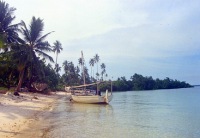
Mafia Island
Mafia Island, along with Pemba and Zanzibar, form the famous Spice Islands off the coast of Tanzania. While the name conjures images of shady criminals and glamorous heists, the re…
Mafia Island
Mafia Island, along with Pemba and Zanzibar, form the famous Spice Islands off the coast of Tanzania. While the name conjures images of shady criminals and glamorous heists, the real riches of Mafia Island lie underwater in its magnificent coral reef system. Mafia Island is a top diving destination for those in the know. Limited accommodation means it's a great place to hide from the tourist crowds on Zanzibar, and provides additional opportunities for fishing and swimming with whale sharks. There are also land-based activities, including trips to the bustling village on tiny Chole Island and the ruined one on Juani Island.
Website www.mafiaisland.com
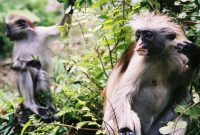
Udzungwa Mountains National Park
Said to be the most biodiverse national park in Tanzania, Udzungwa Mountains National Park is less a magnet for game viewing than for hiking. A network of forest trails crisscrosse…
Udzungwa Mountains National Park
Said to be the most biodiverse national park in Tanzania, Udzungwa Mountains National Park is less a magnet for game viewing than for hiking. A network of forest trails crisscrosses the peaks and offers treks to hidden waterfalls and majestic vistas. A popular hike is the half-day trip to Sanje Waterfall, while the two-day hike along Mwanihana Trail provides panoramic views of the surrounding valleys. Visitors can also hike to cultural and historical sites such as the Mwanaruvele and Magombereka Caves. While Udzungwa Mountains National Park isn't known for its game, there are still plenty of exotic animals to spot, including birds, mammals, reptiles, amphibians, butterfly, and other creatures. The Iringa Red Colobus Monkey, and the Sanje-Crested Mangebay, both found only in Tanzania, can be spotted in the park.


